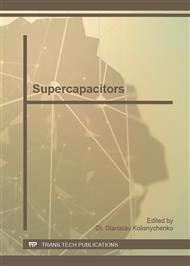[1]
M. Elnashar, M.Kazerani, R.El Shatshat: Comparative Evaluation of Reactive Power compensation Methods for a Stand-Alone Wind Energy Conversion System[C]. Power Electronics Specialists Conference, Rhodes, Jan, 2008, pp.4539-4544.
DOI: 10.1109/pesc.2008.4592679
Google Scholar
[2]
Alvaro Luna, Pedro Rodriguez, Remus Teodorescu: Low Voltage Ride Through Strategies for SCIG Wind Turbines in Distributed Power Generation Systems[C]. Power Electronics Specialists Conference. Rhodes , Jun, 2008, pp.2333-2339.
DOI: 10.1109/pesc.2008.4592290
Google Scholar
[3]
Xing Zhang , Longyun Zhang, Shuying Yang: Proceedings of the CSU-EPSA, vol. 20, No. 4, 2008, pp.1-8(in Chinese).
Google Scholar
[4]
Hongliang Guan, Haixiang Zhao, Weisheng Wang: TRANSACTIONS OF CHINA ELECTROTECHNICAL SOCIETY, vol. 22, No. 10, 2007, pp.173-177(in Chinese).
Google Scholar
[5]
Renjie Ye: Studies of Transient Operational Performance of DFIG Wind Generation System under Grid Fault[D]. ChongQing: Chongqing University, 2009(in Chinese).
Google Scholar
[6]
State Grid Corporation of China-technology regulations of wind farm connection to power grid (recension)[S]. 2009, 2(in Chinese).
Google Scholar
[7]
C. Chompoo-inwai, C. Yingvivatanapong, K. Methaprayoon: IEEE Trans. Ind. Appl., vol. 41, No. 3, 2005, pp.666-672.
DOI: 10.1109/tia.2005.847283
Google Scholar
[8]
Yongning Chi, Hongliang Guan, Weisheng Wang: Automation of Electric Power Systems, vol. 31, No. 2, 2007, pp.95-104(in Chinese).
Google Scholar
[9]
Alan Mullane, Gordon Lightbody, R. Yacamini: IEEE Transactions on Power Systems, vol. 20 No. 4, 2005, pp.1929-1937.
DOI: 10.1109/tpwrs.2005.857390
Google Scholar
[10]
Fan Tang, Tianqi Liu, Xingyuan Li: Power System Technology, vol. 34, No. 4, 2010, pp.163-167(in Chinese).
Google Scholar
[11]
Phatiphat Thounthong, Viboon Chunkag, Panarit Sethakul, Bernard Davat, Melika Hinaje: IEEE Transactions on Vehicular Technology, Vol. 58, No. 8, October 2009, pp.3892-3904.
DOI: 10.1109/tvt.2009.2028571
Google Scholar
[12]
Ruifa Cao, Wu Zhu, Xiangcun Tu: Power System Technology, vol. 33, No. 9, 2009, pp.72-77(in Chinese).
Google Scholar
[13]
Buhan Zhang, Jie Zeng, Chengxiong Mao: Electric Power Automation Equipment, vol. 28, No. 4, 2008, pp.1-4(in Chinese).
Google Scholar
[14]
H. Li, Z. Chen, L. Han: Comparison and Evaluation of Induction Generator Models in Wind Turbine Systems for Transient Stability of Power System[C]. International Conference on Power System Technology, 2006, pp.1-6.
DOI: 10.1109/icpst.2006.321516
Google Scholar



